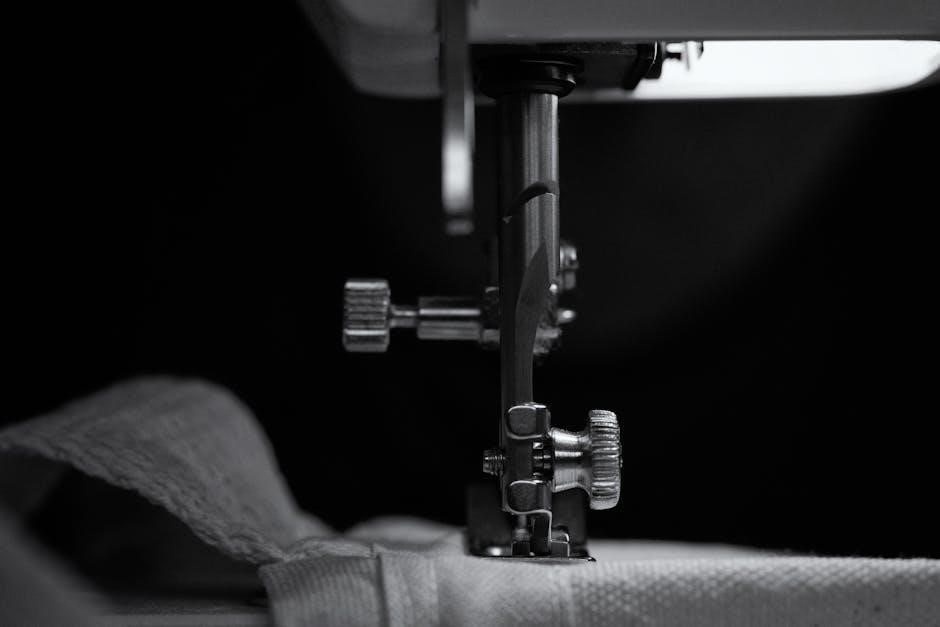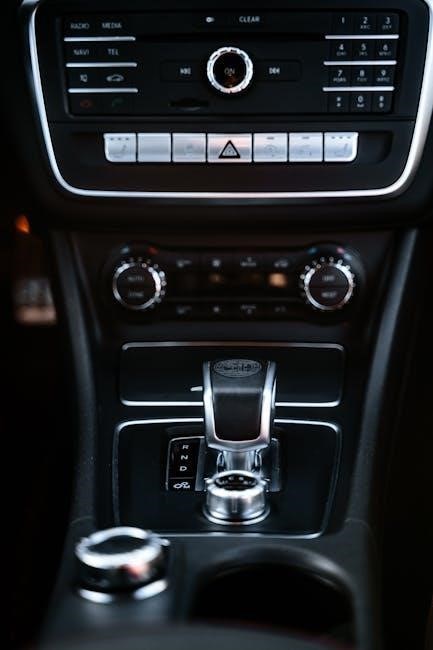
Manual and automatic turntables offer distinct listening experiences, catering to different preferences and needs․ Understanding their operation, sound quality, and maintenance requirements helps vinyl enthusiasts make informed choices for their setup․
Overview of Turntables
Turntables are devices designed to play vinyl records, offering a tactile and immersive way to enjoy music․ They consist of a rotating platter, a tonearm, and a cartridge that reads the grooves on the record․ Turntables are categorized into two main types: manual and automatic․ Manual turntables require users to lift and place the tonearm onto the record, providing direct control over playback․ In contrast, automatic turntables feature mechanisms that lift and lower the tonearm automatically, simplifying the process․ Both types aim to deliver high-quality audio reproduction but cater to different user preferences and listening habits․ Understanding their design and operation is essential for selecting the right turntable for your needs․ This overview sets the foundation for exploring the differences between manual and automatic models in greater detail․

Importance of Choosing the Right Turntable
Selecting the right turntable is crucial for optimizing your vinyl listening experience․ Whether you prefer manual or automatic models, the choice significantly impacts sound quality, ease of use, and long-term satisfaction․ A well-suited turntable ensures proper record playback, preserving the integrity of your vinyl collection․ Manual turntables often appeal to audiophiles who value precise control and high-fidelity sound, while automatic models offer convenience for casual listeners․ The wrong choice may lead to subpar audio performance or maintenance issues․ Considering factors like budget, lifestyle, and personal preference helps narrow down the options․ Investing time in research ensures a turntable that aligns with your needs, enhancing your enjoyment of vinyl records․ Ultimately, the right turntable becomes a valued component of your home audio system, providing years of reliable service and musical pleasure․

Understanding Manual Turntables
Manual turntables require users to place the tonearm and lift it at the end, offering precise control and often better sound quality, appealing to audiophiles seeking a more immersive experience․
Definition and Operation
A manual turntable requires the user to handle the tonearm and record placement entirely by hand․ It involves placing the record on the platter, lifting the tonearm, and positioning it at the beginning of the record groove․ Once the motor is turned on, the platter spins, and the needle tracks the grooves, playing the music․ At the end of the record, the user must manually lift the tonearm and return it to its rest position․ This process demands attention and care, as mishandling can damage the needle or record․ The manual operation allows for precise control over playback, making it a preferred choice for audiophiles who value tactile engagement and high-fidelity sound․ Regular maintenance, such as cleaning the record and checking the cartridge alignment, is also essential for optimal performance․
Pros of Manual Turntables

Manual turntables are highly regarded for their superior sound quality, often preferred by audiophiles․ They provide a more immersive listening experience due to the direct connection between the record and the stylus․ The absence of automatic mechanisms ensures minimal interference, leading to a cleaner and more accurate sound reproduction․ Additionally, manual turntables tend to be more durable and long-lasting, as they have fewer moving parts that can wear out․ They also offer a tactile and engaging experience, allowing users to feel more connected to their music․ Furthermore, manual turntables are typically easier to maintain and repair, making them a cost-effective choice in the long run․ Overall, they are ideal for those who prioritize sound quality and are willing to invest time and effort into their vinyl setup․
Cons of Manual Turntables
Manual turntables require a higher level of user involvement, as they demand careful placement of the tonearm and manual lifting at the end of the record; This can be inconvenient for some users, especially those who prefer a hands-off experience․ Additionally, manual turntables lack the convenience of automatic features, such as cueing and automatic return, which can be a drawback for casual listeners․ They also require more precision and care to avoid damaging the needle or the record․ Furthermore, manual turntables may not be as accessible for newcomers, as they involve a learning curve in handling the tonearm correctly․ The absence of automation also means users must monitor the playback process closely, which can be less appealing for those seeking simplicity and ease of use․

Understanding Automatic Turntables
Automatic turntables simplify vinyl playback by automating tonearm placement and lift, offering convenience for casual listeners․ They are ideal for those seeking ease of use and minimal manual intervention․
An automatic turntable is a device designed to play vinyl records with minimal user intervention․ It operates by automatically lifting and placing the tonearm onto the record, ensuring precise placement at the start of the groove․ Once the record is finished, the tonearm is automatically lifted and returned to its resting position․ This automation eliminates the need for manual handling, making it more convenient for casual listeners․ The motor spins the platter at consistent speeds, typically selectable between 33⅓ and 45 RPM, depending on the record format․ Automatic turntables are ideal for those who value ease of use and want to enjoy their vinyl collection without the hassle of manual adjustments․ Their design focuses on simplicity and accessibility, appealing to both newcomers and experienced audiophiles seeking a hands-off experience․
Pros of Automatic Turntables
Automatic turntables offer unparalleled convenience and ease of use, making them ideal for casual listeners and those new to vinyl․ They eliminate the need for manual tonearm placement, reducing the risk of accidental scratches or damage to the record․ The automatic start and stop features ensure smooth playback, while the consistent motor speed provides reliable performance․ Additionally, automatic turntables often come with built-in phono preamps, simplifying connectivity to speakers or amplifiers․ Their sleek designs and user-friendly interfaces appeal to modern aesthetics, blending seamlessly into home decor․ Furthermore, automatic turntables are generally low-maintenance, requiring less adjustments and calibration compared to manual models․ This makes them a practical choice for those seeking a hassle-free vinyl experience without compromising on sound quality․ Their convenience and accessibility have made them a popular option for many music enthusiasts․
Cons of Automatic Turntables
Automatic turntables, while convenient, have several drawbacks that may deter some audiophiles․ One notable disadvantage is the higher cost compared to manual models, especially for high-quality units․ Additionally, the automated mechanism can introduce wear and tear on the record and tonearm over time, potentially leading to mistracking or misalignment․ The tonearm on automatic turntables is often less precise, which may compromise sound quality․ Furthermore, the automatic start and stop features can sometimes cause the needle to drop improperly, risking damage to the record․ Some users also find the lack of manual control less engaging, as it removes the tactile experience of placing the needle․ Lastly, automatic turntables are more reliant on electronic components, which can malfunction or require repairs, adding to maintenance costs․ These factors make manual turntables a preferred choice for purists seeking precision and durability․

Key Differences Between Manual and Automatic Turntables
Manual turntables require manual tonearm placement and offer precise control, appealing to audiophiles․ Automatic turntables automate this process, providing convenience but potentially compromising sound quality and tactile experience․
Sound Quality Comparison
Sound quality is a critical factor when comparing manual and automatic turntables․ Manual turntables are often praised for their superior audio fidelity, as they minimize mechanical interference and allow for precise control over the tonearm placement, reducing the risk of distortion․ The direct connection between the motor and the platter in manual models ensures consistent rotation speed, which is vital for accurate sound reproduction․ Automatic turntables, while convenient, may introduce slight mechanical noise during operation, potentially affecting sound purity․ However, high-end automatic models can still deliver excellent sound quality, though they often come at a higher cost․ Ultimately, manual turntables are generally preferred by audiophiles for their ability to maintain pristine sound reproduction, while automatic models balance convenience with slightly compromised audio performance․
Ease of Use
Manual and automatic turntables differ significantly in terms of ease of use․ Manual turntables require users to lift and place the tonearm onto the record, which can be a bit tricky for newcomers․ This process demands care to avoid scratching the record or misaligning the needle․ Automatic turntables, however, simplify the experience by automatically lifting and placing the tonearm at the start and end of playback, making them more user-friendly and accessible to casual listeners․ This convenience is particularly appealing for those who value simplicity and don’t want to handle the tonearm manually․ While manual turntables offer greater control for audiophiles, automatic models are ideal for individuals seeking a hassle-free vinyl listening experience․ The choice ultimately depends on whether convenience or hands-on involvement is more important to the user․
Maintenance Requirements
Maintenance requirements differ between manual and automatic turntables, impacting long-term performance and sound quality․ Manual turntables generally require less complex maintenance since they have fewer moving parts․ Users must clean the tonearm and cartridge regularly, ensure proper alignment, and occasionally check the motor for stability․ However, the lack of automation means users must handle the tonearm carefully to avoid damage․ Automatic turntables, while convenient, have more mechanical components, such as the auto-lift mechanism, which may require additional upkeep․ These parts can wear out over time, leading to potential repairs or replacements․ Both types benefit from regular record cleaning and stylus care to maintain optimal sound quality․ Overall, manual turntables are simpler to maintain for experienced users, while automatic models may need more attention to their mechanical systems to ensure reliable operation․

Cost Considerations
Manual and automatic turntables vary significantly in price, with manual models often being more affordable due to fewer mechanical components, while automatic turntables, offering convenience, typically cost more․
Price Range of Manual Turntables
Manual turntables are generally more affordable than their automatic counterparts, making them a popular choice for vinyl enthusiasts on a budget․ Entry-level manual turntables typically start around $100 to $300, offering basic yet reliable performance․ Mid-range models, often preferred by audiophiles, fall between $300 and $800, featuring improved build quality, better materials, and enhanced sound reproduction․ High-end manual turntables can range from $800 to several thousand dollars, catering to serious collectors and professionals who prioritize premium craftsmanship and superior audio fidelity․ Brands like Pro-Ject, Audio-Technica, and Rega offer a wide range of options across these price tiers, ensuring there’s a manual turntable to suit every listener’s needs and budget․
Price Range of Automatic Turntables
Automatic turntables generally fall into a higher price range compared to manual models due to their advanced features and convenience․ Entry-level automatic turntables typically start around $300 to $600, offering basic automation features like tonearm lifting and playback start/stop functionality․ Mid-range automatic turntables, which often include better build quality, improved sound reproduction, and additional features like multiple speed settings, range from $600 to $1,200․ High-end automatic turntables can cost $1,200 or more, featuring premium materials, precise engineering, and advanced audio technologies․ Brands like Sony, Audio-Technica, and Crosley offer a variety of automatic turntables across these price tiers, catering to both casual listeners and audiophiles who value convenience without compromising on sound quality․ While they are generally more expensive than manual turntables, automatic models provide a hassle-free listening experience that many find worth the investment․
Value for Money Analysis
When evaluating value for money, manual and automatic turntables cater to different priorities․ Manual turntables often offer better value for audiophiles seeking high sound quality and precision, as they typically require a lower initial investment while delivering excellent performance․ Automatic turntables, while more expensive, provide convenience and ease of use, making them a worthwhile investment for casual listeners or those who value simplicity․ Entry-level automatic turntables can be a good middle ground, offering decent sound quality and automation at an accessible price․ However, high-end automatic models may not always justify their higher cost unless advanced features are essential․ Ultimately, the value lies in aligning the turntable’s capabilities with the user’s needs, ensuring that the chosen model strikes the right balance between cost, performance, and convenience․ Both types have their merits, making them suitable for different budgets and preferences․

Performance and Features
Manual turntables often excel in sound quality due to precise motor control and minimal interference, while automatic turntables offer convenience with features like auto-start and Bluetooth connectivity for modern needs․
Motor Quality and Speed Consistency
Motor quality and speed consistency are critical factors in turntable performance, directly impacting sound reproduction․ Manual turntables typically feature high-quality motors designed for precise speed control, ensuring minimal vibration and accurate playback․ These motors often require manual adjustment, but they provide consistent rotation, which is essential for maintaining the integrity of the audio signal․ Automatic turntables also rely on motors, but their operation involves additional mechanical components for automation, which can sometimes introduce slight variations in speed consistency․ High-end automatic turntables, however, often include advanced motor systems with electronic speed control, minimizing deviations․ Both types prioritize stable motor performance, but manual turntables are generally favored by audiophiles for their precision, while automatic turntables balance convenience with reliable operation․
Tonearm and Cartridge Differences
The tonearm and cartridge are essential components of a turntable, and their design varies between manual and automatic models․ Manual turntables often feature adjustable tonearms, allowing users to fine-tune settings like tracking force and anti-skate, which can enhance sound quality and reduce wear on records․ The cartridge, typically user-replaceable, offers flexibility for upgrading or customizing the sound․ Automatic turntables, while convenient, may have less adjustable tonearms and cartridges, as automation prioritizes ease of use over customization․ However, high-end automatic turntables can still include premium cartridges and tonearms, delivering excellent sound quality․ Manual turntables are favored by audiophiles for their adjustability and potential for upgrades, whereas automatic turntables cater to users seeking a plug-and-play experience without compromising on performance․
Additional Features (e․g․, USB, Bluetooth)
Modern turntables often come with additional features that enhance functionality and connectivity․ Manual turntables may include USB ports for digitizing vinyl records to digital formats, appealing to audiophiles who want to preserve their collections․ Some manual models also offer Bluetooth connectivity, allowing wireless streaming to speakers or headphones․ Automatic turntables frequently incorporate built-in phono preamps, simplifying setup for users without external audio equipment․ Bluetooth and USB capabilities are also common in automatic turntables, catering to those who value convenience and modern connectivity․ While manual turntables tend to focus on analog purity, automatic turntables often prioritize versatility with features like wireless streaming and digital conversion․ These additions make automatic turntables more accessible to casual listeners, while manual turntables remain popular among purists who emphasize sound quality and customization․